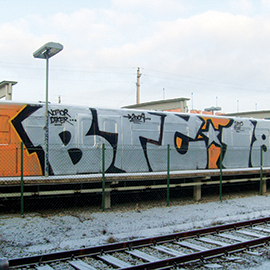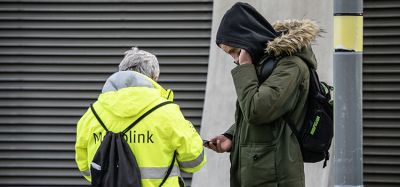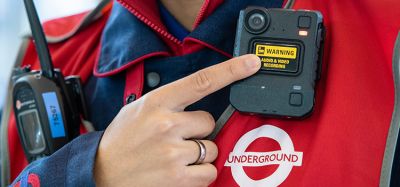Graffiti in public transport systems – crime, not art
- Like
- Digg
- Del
- Tumblr
- VKontakte
- Buffer
- Love This
- Odnoklassniki
- Meneame
- Blogger
- Amazon
- Yahoo Mail
- Gmail
- AOL
- Newsvine
- HackerNews
- Evernote
- MySpace
- Mail.ru
- Viadeo
- Line
- Comments
- Yummly
- SMS
- Viber
- Telegram
- Subscribe
- Skype
- Facebook Messenger
- Kakao
- LiveJournal
- Yammer
- Edgar
- Fintel
- Mix
- Instapaper
- Copy Link
Posted: 30 June 2015 | Andrea Soehnchen, Senior Project Manager/Business Developer, and Lindsey Mancini, Security Manager, UITP
Graffiti and vandalism are growing concerns of the public transport industry. Whilst operators strive to provide high-quality services for their passengers, graffiti tags and pieces have a substantial impact. The presence of graffiti within a public transport system gives the impression of a neglected environment and negatively affects the comfort and security perception of passengers. Furthermore, if graffiti sprayers can penetrate the system, who else could? The UITP’s Andrea Soehnchen (Senior Project Manager/Business Developer) and Lindsey Mancini (Security Manager) take a look at how graffiti crime causes major costs for cleaning, repair and extra security measures to prevent further incidents.


Whilst the public sector has a rather clear view on the phenomenon, in the public mind graffiti is often seen as less of a criminal act and more a life-style issue, with the additional challenge of the ‘romantic’ idea of the graffiti scene as underground ‘artists’. However, public transport operators and passengers ultimately pay the price.
Trends of graffiti in public transport
According to an international survey of UITP members , graffiti incidents for most are either stable in number or increasing in frequency, indicating that the problem is here to stay for the time being. Small tags (a stylised signature) and large pieces (complex graffiti that can cover entire walls, carriages or trains) are the most common, affecting 85% and 78% of respondents respectively. Acid etching is less common, affecting 45%. Graffiti tends to appear on rolling stock and in stations, with tunnels, bridges and trackside also affected. However, all areas of the infrastructure can be targeted (bus stops, signal rooms, viaducts etc.). Rolling stock, being the most common target, is most often attacked in depots or in sidings; however, 59% of respondents also report attacks occurring during operating service.
From the survey, 96% of respondents suffer graffiti from local sprayers. However, more than half also report sprayers from other countries. The costs related to graffiti vary greatly between respondents, mainly due to different ways of calculating both direct and indirect costs incurred. One respondent reported up to €17 million per year, with another indicating that graffiti costs represent 1% of total costs of their operations. Many respondents report annual costs to be in the millions of Euros. For the majority, costs are either rising or are stable.
Deterrent measures
In terms of measures employed to fight graffiti, video surveillance and staff patrols are the most commonly deployed measures, and zero-tolerance policies are very widely used (see Figure 4). A variety of other specific measures exist such as fencing and protective films. In terms of policy measures, public awareness campaigns and cooperation with police are also common.
The UITP intends to repeat this survey in order to evaluate the evolution of trends. However, even from this first survey it is worth noting two major trends emerging in recent years:
Violent modus operandi
Many public transport networks have become highly effective at protecting themselves from the traditional methods of sprayers. For example, protecting trains in depots is relatively straight-forward with a variety of options in terms of measures – i.e. fencing, intrusion detection, video surveillance with analytics, staff patrols etc. But sprayers adapt their methods, which is why attacks on rolling stock in sidings and even during service is increasingly common. In Spain the phenomenon known as ‘palazacos’ is particularly worrying and it is also beginning to appear in other countries. This involves a gang of sprayers boarding the train whilst in service, pulling the emergency brake to stop the train, effectively taking the other passengers hostage whilst spraying the train.
We also know that sprayers are willing to take more risks and in some cases are increasingly violent, assaulting staff and destroying driver cabins and surveillance cameras as a matter of course.
Finally, gangs are very well organised. They conduct reconnaissance activities to identify weak points, steal keys, uniforms and other items to gain easier access. They are often linked to other illegal activity, including theft in order to fund the spraying. They carry out dry runs and practices, with each gang member having a specific role in order to carry out the hit as quickly and efficiently as possible. A quick search on YouTube will enlighten you further.
Internationalisation
The internationalisation of graffiti activity is the most interesting trend to note. Also known as ‘graffiti tourism’, it involves gangs from different countries linking up with one another and travelling to each other’s home city to carry out hits. The host gang will often offer reconnaissance information such as how best to access to target, location of surveillance cameras, schedule of patrols, and so on. Graffiti tourism is a specific problem for operators as it is very hard to prosecute foreign sprayers who have already left the country. A local court is not likely to take into account the hundreds of thousands of Euros worth of damage the sprayer has caused in other countries as there is currently very little international linkage between police forces.
Figure 5 shows an example of a German graffiti gang’s (known) activity in Europe. Known by the tags ‘BTC180-iPOD’, more than 150 cases were recorded in Austria alone between 2006 and 2010. But the tag was also spotted in Madrid, Milan, Munich, Hamburg and Berlin.
Challenges to tackle the problem
Legal issues
Even if graffiti writers are identified and apprehended, today the prosecution of sprayers often proves difficult as authorities often only consider the tag or piece as damage, not the incident and related damage behind it.
There are substantial international differences in the weight and relevance attached to graffiti. While some European countries are recognising the problem and starting to impose more serious consequences, others have de-penalised graffiti and made it almost impossible for public transport operators to get any compensation for the damage occurred. In many countries, such as Austria, the courts simply take into consideration the physical damage incurred, even though it is thought that this accounts for only 1/10 of the total costs.
While local offenders may still be charged, graffiti sprayers increasingly work abroad and have already left the country by the time they may be identified. Transnational cooperation of law enforcement needs to be improved to close this gap.
Costs
Costs are not only directly linked to the graffiti damage and the cleaning, but it also involves damage such as further vandalism, forced access, spilled chemicals, and so on. Operational down-time and service disruptions due to the removal of a sprayed train for cleaning has a cost. There are administrative and bureaucratic costs related to investigating the incident, reporting a crime and prosecuting an offender. A common measure used to fight graffiti is increased staff presence and patrols, but this is very costly for public transport operators, as are additional technical measures such as video surveillance. And finally, losing customer confidence and damage to company reputation has a cost, which should not be underestimated.
Image and communication
Today, many public transport operators adopt a zero-tolerance policy towards graffiti, not allowing vehicles covered with graffiti to enter service, in order to prevent graffiti from negatively impacting customers’ perception. Yet, having to take trains or buses out of operation because they need to be cleaned can leave a public transport operator short of rolling stock and struggling to provide an attractive level of service for customers, especially during peak hours.
Customers need to be given an explanation for delays and difficulties. The challenge is to find the balance between awareness raising regarding the problem, negative impact on security perception, and providing publicity to graffiti sprayers.
A graffiti-free future?
Graffiti on the property of public transport companies should not be seen as a nuisance, but a security problem: graffiti means intrusion, destruction or theft.
Of course, not all graffiti writers can be measured by the same standard – some are opportunistic and thrill-seeking, others have elected public transport as their stage in order to climb the ranks within the graffiti scene, often at high costs.
Educational campaigns and programmes may help to raise awareness for the damage and danger of graffiti, especially among younger people. Indeed, we have already seen projects where schools ‘adopt’ public transport stations and help to keep them clean and therefore understand the effort it takes to constantly remove dirt and damage caused by badly considered behaviour.
Some public transport operators have established offender management programmes aiming to ‘give a second chance’ to first and not criminal offenders. Provided that sprayers cooperate, help to compensate the damage caused, and do not commit any further offence, such programmes offer public transport operators the chance to consider the offender as ‘rehabilitated’ and do not press further charges.
While such soft measures may help dissuade people that are just fascinated by the underground character of the graffiti scene, public transport operators also need to find more efficient strategies to deal with repeat and criminal offenders. Such strategies could include:
- Technology and careful investigation to help detect weaknesses and in turn to improve security concepts and systems
- Systematic incident reporting and evaluation which will provide evidence for the damage caused by graffiti activity and raise awareness to prosecution authorities to the severity of the crime
- A closer cooperation with law enforcement agencies to improve quality and hence validity of evidence collected for the court
- Improved international cooperation between public transport stakeholders, leading to the better exchange of information and good practices.
The UITP is committed to raising awareness that graffiti in public transport is not art, nor is the problem simply kids misbehaving. It is conducted by organised gangs intent on causing maximum damage, regardless of the danger to themselves or others. Operators count costs of millions of Euros per year – money that should be better spent on improving the public transport service for the benefit of society, the economy and the environment. Graffiti is a serious problem and it is high time it gets the attention it deserves.
Reference
- Survey conducted thanks to funding from the European Commission, DG MOVE.
Biography
Andrea Soehnchen is a graduate Civil Engineer, specialising in infrastructure and transport planning. She joined the UITP in 2001 as a European Project Manager and built up the UITP’s security-related activities in the wake of the bombings in Madrid and Moscow. After some years working for Securitas, a leading private security company, Andrea joined the UITP again and took responsibility for business development within the organisation.
With a Master’s Degree from the University of St Andrews, UK, Lindsey Mancini joined the UITP in 2005 where she is responsible for all security-related activities. She manages the Security Commission, a platform of exchange for security experts from public transport operators and authorities, as well as coordinating its various working groups. She is responsible for organising, and the programmes of, security-related events, publications and training programmes. Lindsey is also the Regional Officer for North America and Project Manager for the UITP’s flagship event, the Global Public Transport Summit (Montréal, 2017).
Related topics
Security & Crime
Issue
Issue 3 2015
Related organisations
International Association for Public Transport (UITP)







